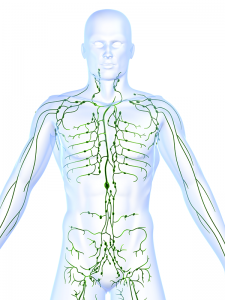By Eva Briggs

Swollen glands is a misnomer, a term people often use for enlarged lymph nodes. Your body creates lymphatic fluid, which moves from your blood vessels to surround the cells in your body’s tissues. This fluid carries oxygen and nutrients that your cells need, and delivers white blood cells. The lymphatic fluid collects waste products and other unwanted substance, like bacteria and viruses. A system of lymphatic vessels gathers the lymphatic fluid for removal from the body’s tissues and eventual return to the circulation. The lymphatic vessels drain through lymph nodes, tiny filters for removing unwanted substance. The lymph nodes also contain immune cells to destroy invading viruses and bacteria. When experiencing issues with your lymphatic system, you may want to consider the benefits of getting a lymphatic drainage massage.
Lymph nodes are found throughout the body. Most people are familiar with cervical lymph nodes located in the neck — these are the ones that often swell with a sore throat. You also have spraclavicular lymph nodes above your collarbones, axillary nodes in your armpits, inguinal nodes in your groin, epitrochlear nodes near the elbow, as well as lymph nodes in your chest and abdomen.
Normal lymph nodes are less than 0.5-1 cm, depending on their location. Painful lymph nodes, or nodes with an abnormal consistency such as hard or woody rather than rubbery, are abnormal.
The mnemonic MIAMI indicates the causes of lymphadenopathy (enlarged lymph nodes): Malignancies, Infections, Autoimmune disorders, Miscellaneous/unusual conditions, and Iatrogenic (caused by medical treatment).
Malignancy, or cancer, includes lymphoma, cancer of the lymph nodes themselves, as well as spread from internal cancers or skin cancer. Cancer can spread to lymph nodes that drain lymphatic fluid from the region where the primary cancer is located. For example, breast cancer could spread to lymph nodes in the nearby armpit. Or the cancer can metastasize, spreading to lymph nodes in more distant body areas. The presence of cancer in lymph nodes is a feature used to determine the stage of many cancers.
As with cancer, infection may cause lymph nodes to enlarge in the region of an infection, as when an infected cut on your leg causes lymph nodes in the groin to enlarge. Systemic, more widespread infections affect multiple lymph node areas, as in people with mononucleosis. Infectious causes can be bacterial, viral, or fungal.
Autoimmune disorders encompass rheumatoid arthritis, Sjogren’s syndrome, and others. An assortment of miscellaneous conditions may cause lymphadenopathy, such as Kawasaki disease and sarcoidosis.
Serum sickness, a type of reaction to a drug, is an example of iatrogenic lymphadenopathy.
Given so many possible causes, how might your doctor figure out the cause of enlarged lymph nodes?
The first step will be history. How old is the patient? Most children with lymphadenopathy don’t have a dangerous or worrisome cause. How long has it lasted? If it’s less than two weeks it’s usually safe to watch. And if lymph nodes have been enlarged for more than a year without changing, it’s less likely to be serious.
What have you been exposed to? Travel, animals and insects are clues. Any medicines or exposure to sick contacts should be noted. Use of tobacco products is a risk factor for malignancy.
Do you have other symptoms? Fever, unexplained weight loss, weakness, night sweats can suggest possible etiologies.
After exploring your history, an exam is the next step. This helps determine which lymph node areas are affected. Your doctor will look for things like rashes and skin lesions, enlargement of internal organs, heart and lung sounds.
Based on the results of history and exam, your doctor might observe for a while or order testing. Laboratory studies can search for infection and autoimmune disease. CT, MRI or ultrasound can visualize the lymph nodes. Sometimes an actual sample of the enlarged lymph node will be obtained by a needle or by a surgical biopsy.
Of course, the treatment will be tailored to the specific cause.
Eva Briggs is a medical doctor who works at two urgent care centers (Central Square and Fulton) operated by Oswego Health.

